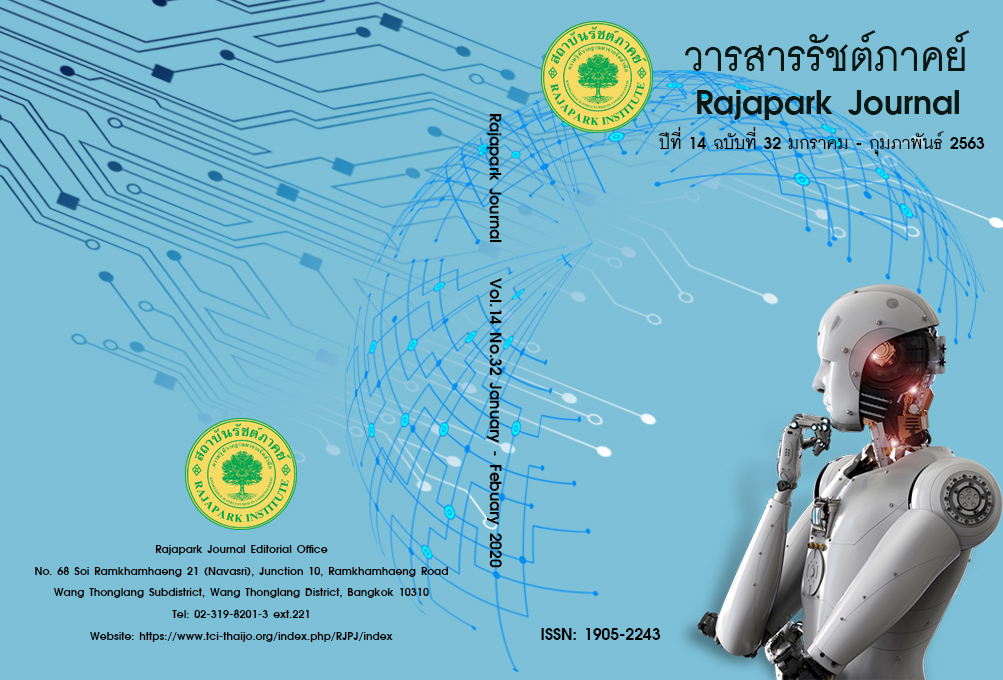The Analysis of the Implementation of the Computer-Related Crime Act B.E. 2550
Main Article Content
Abstract
This research aimed to analyze and identify factors affecting the implementation of the Computer-Related Crime Act B.E. 2550. Samples composed of 30 relevant officials under Ministry of Digital Economy and Society, Royal Thai Police, and Department of Special Investigation, and 70 public and private Internet operators. Data collected through a reliability-tested questionnaire were analyzed via analysis of variance, analysis of covariance, and multiple regression analysis. The findings indicated that legal implementation by the authorized persons was effective at a moderate level, and factors affecting legal implementation were implementers’ behavior and legal entity structure.
Article Details

This work is licensed under a Creative Commons Attribution-NonCommercial-NoDerivatives 4.0 International License.
Views and opinions appearing in the Journal it is the responsibility of the author of the article, and does not constitute the view and responsibility of the editorial team.
References
Barrett, S., & Fudge, C. (Eds.). (1981). Policy and action. London: Meuthuen.
Ben-Zadok, E. (2006). Solid theory and soft implementation in policy design: Florida compact development policies. International Planning Studies, 11(1), 59–81.
Brenner, S. W. (2012). Cybercrime and the law: challenges, issues, and outcomes. Boston: Northeastern University Press.
Butler, M. J. R. (2003). Managing from the inside out: Drawing on ‘receptivity’ to explain variation in strategy Implementation. [Special Issue], British Journal of Management, 14, S47–S60.
Cohen, L. E., & Felson, M. (1979). Social change and crime rate trends: A routine activity approach. American Sociological Review. 44(4), 588–608.
Edwards, G. C. III. (1980). Implementing public policy. Washington, DC: Congressional Quarterly.
Goggin, M. L., Bowman, A. O., Lester, J. P., & O'Toole, L. J., Jr. (1990). Implementation theory and practice: Toward a third generation. Glenview, IL: Scott, Foreman/Little, Brown.
Hill, J. B., & Marion, N. E. (2016). Introduction to cybercrime: Computer crimes, laws, and policing in the 21st century. Santa Barbara, CA: Praeger.
Hirschi, T. (1969). Causes of delinquency. University of California Press.
Jaishankar, K. (2008). Space Transition Theory of cyber crimes. In Schmallager, F., & Pittaro, M. (Eds.), Crimes of the Internet (pp. 283-301). Upper Saddle River, NJ: Prentice Hall.
Lertkitikul, P. (2007). The Computer-Related Crime Act 2007: A case study of criminal liability in access to computer system and computer data. Bangkok: Chulalongkorn University.
Mazmanian, D., & Sabatier, P. A. (1983). Implementation and public policy. Glenview, Ill.: Scott, Foresman.
Moore, R. (2005). Cybercrime: Investigating high-technology computer crime. Cleveland, MS: Anderson Publishing.
Nakamura, R. T., & Smallwood, F. (1980). The politics of policy implementation. New York: St. Martin's.
Napibul, A. (2008). Problems and obstacles of the enforcement of the Computer Crime Act B.E. 2550. Bangkok: Chulalongkorn University.
Onpueng, S. (2011). The enforcement of computer related crime act B.E. 2007: a case study of offence relating to dissemination of information regarding the security of the Kingdom. Bangkok: Chulalongkorn University.
Parker, S. N., & Oüra, S. S. (1973). Computer abuse. Menlo Park, CA: Stanford Research Institute.
Pressman, J. L. & Wildavsky, A. (1973). Implementation. Berkeley: University of California Press.
Ryan, N. (1996). Some advantages of an integrated approach to implementation analysis: A study of Australian industry policy. Public Administration, 74, 737-753.
Sabatier, P. A. (1991). Towards better theories of the policy process. Political Science and Politics, 24(2), 147-156.
Sakdulyatham, S. (2008). Knowledge, impact assessment and behavior tendency of internet users about the Computer Crime Act B.E. 2550. Bangkok: Chulalongkorn University.
Schofield, J. (2001). Time for revival? Public policy implementation: A review of the literature and an agenda for future research. International Journal of Public Administration, 3(3), 245-263.
Terpstra, J., & Havinga, T. (2001). Implementation between tradition and management: Structuration and styles of implementation. Law and Policy, 23(1), 95-116.
Van Meter, Donald S., & Van Horn, Carl E. (1975). The policy implementation process: A conceptual framework. Administration & Society, 6(4), 445-488.
Vangen, Siv., & Huxam, Chris. (2003). Enacting leadership for collaborative advantage: Dilemmas of ideology and pragmatism in the activities of partnership managers. British Journal of Management, 14, S61–S76.


